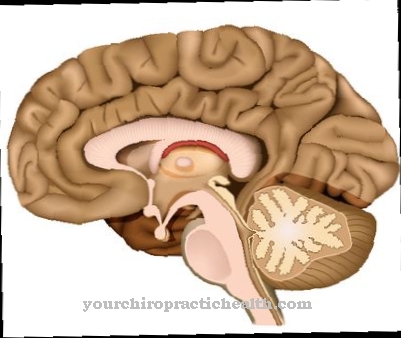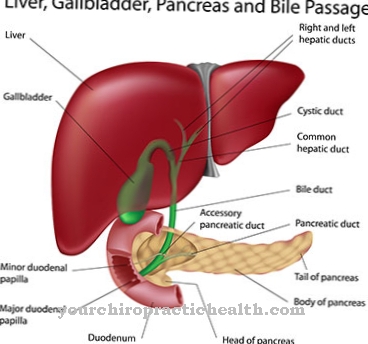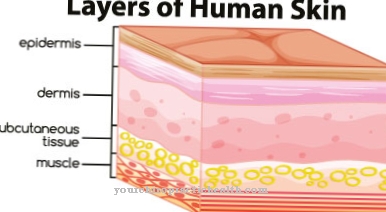The Endophthalmitis is an inflammation of the inside of the eye. It is caused by infections in the eye.
What is endophthalmitis?

© miro kovacevic - stock.adobe.com
Endophthalmitis is an extremely rare disease that is feared because of its serious consequences. In the United States, there are around 1200 postoperative endophthalmitis cases each year. The incidence in Germany after cataract operations is around 0.08 percent. The disease can also occur with minor interventions. Endophthalmitis is an inflammatory reaction inside the eye.
This inflammation is usually due to an infection with microorganisms. In contrast to panophthalmitis, the inflammation only affects the interior of the eye and not the entire eye. In exogenous endophthalmitis, a distinction can be made between an exogenous and an endogenous form. In endophthalmitis, the pathogens get into the eye from the outside.
Endogenous endophthalmitis is associated with the spread of germs via the bloodstream. The main symptom of endophthalmitis is dull pain and blurred vision. The prognosis for endophthalmitis is extremely poor. In extreme cases, the eye must be removed.
causes
Endophthalmitis is caused by microorganisms. With an exogenous infection, the pathogens get into the eye through injuries. For example, exogenous endophthalmitis can occur after an eye operation in non-sterile operating conditions. Exogenous endophthalmitis is the more common form. Endogenous endophthalmitis occurs less frequently. Here the infection has its origin in another organ.
The pathogens spread through the body via the bloodstream. This process is also known as sepsis or blood poisoning. Sepsis is usually caused by bacteria. It occurs as a result of surgical complications, eye injuries and in immunocompromised patients such as diabetics or AIDS patients.
Bacteria, viruses and parasites can cause endophthalmitis. Enterococci, Klebsiella pneumoniae, Bacillus spp., Proteus spp., Streptococci, staphylococci, mycobacteria and Treponema pallidum are possible pathogens for bacteria. Candida albicans and other Candida species, Aspergillus spp., Mucor species, Penicillium and Blastomyces dermatitidis are fungi that can cause an infection of the interior of the eye.
Other possible pathogens are the human cytomegalovirus, the herpes simplex virus, the measles virus, the rubella virus and the varicella zoster virus. Parasites that can cause endophthalmitis include Taenia solium, Toxoplasma gondii, and Toxocara canis (dog roundworm).
You can find your medication here
➔ Medicines for eye infectionsSymptoms, ailments & signs
Dull and severe pain in the eye is typical of endophthalmitis. The eyesight deteriorates massively and there is a strong sensitivity to light (photophobia). The eyelids are swollen. In medical terminology, this phenomenon is known as eyelid edema. The conjunctiva is increasingly supplied with blood. This conjunctival hyperemia manifests itself as reddening of the eyes.
Not only the eyelids but also the conjunctiva can be swollen. The edema of the conjunctiva is called chemosis. The conjunctiva stands out like a bubble from the dermis (sclera). The cornea is also swollen. Water is stored in the stroma of the cornea. This leads to the fact that the arrangement of the collagen lamellae in the cornea is disturbed and the thickness of the cornea increases.
This reduces the transparency of the cornea and makes it appear milky-cloudy. There is a deterioration in vision with circular appearances around light sources (halos). A characteristic phenomenon in endophthalmitis is the Tyndall phenomenon. This is a clouding of the aqueous humor that is caused by an increased content of inflammatory cells and proteins.
In addition, pus can form in the anterior chamber of the eye (hypopyon). In backlight tests, the pupils light up whitish. This phenomenon is also called leukocoria. In addition, the vitreous humor can be infiltrated and clouded. In contrast to panophthalmitis, endophthalmitis only affects the interior of the eyes. The eye shell is free from inflammation.
diagnosis
If endophthalmitis is suspected, an ultrasound examination is performed. The pathogen is then detected from the aqueous humor and from the vitreous humor. Identifying the pathogen is important for therapy. Endophthalmitis can be caused by many different pathogens, so that a determination of the pathogen is necessary to choose the right drug.
Complications
In the case of endophthalmitis, act quickly. Depending on which pathogen triggered the endophthalmitis in a specific case, different drugs are used. In the case of a bacterial infection, these are antibiotics that are given both locally to the eye (e.g. as drops or as a cream around the eye) and as part of systemic therapy.
The high-dose antibiotic used in a systemic combination can lead to side effects, such as severe fatigue, malaise, severe diarrhea or partial destruction of the intestinal flora. When penicillin is given, allergic reactions often occur, which can range from skin irritation to allergic shock.
If endophthalmitis is left untreated, the inflammation will spread very quickly. Due to the severe damage to the eye, untreated endophthalmitis leads to a complete loss of vision, sometimes to a loss of the entire eye. Another complication that is indirectly related to endophthalmitis is the resistance of the pathogen.
In the event of resistance, bacteria can no longer be treated with common antibiotics. Resistance means that diseases caused by bacteria - and thus also endophthalmitis - can be treated increasingly poorly.
When should you go to the doctor?
There is cause for concern if there are changes in normal vision. Consult a doctor if you are sensitive to light or have decreased vision. If a headache sets in or if you feel pressure inside your head, you need to see a doctor. Before taking pain medication, it is necessary to consult a doctor to clarify possible risks and side effects.
A doctor should be consulted if the eyes are swollen or watery or if the eye is itchy. Discoloration of the skin around the eyes or on the retina is considered unusual and should be examined medically. If the cornea swells up, see a doctor as soon as possible. A clouding of the eye or a milky discoloration should be presented to a doctor and examined by him. If pus forms, the risk of blood poisoning increases.
A doctor's visit is necessary so that a life-threatening condition cannot develop. A doctor's visit is also necessary in the event of emotional problems. If fear or behavioral problems arise, a doctor or therapist should be consulted. Aggressive or hysterical behavior is a cause for concern and should be discussed. If there is a reduction in performance, disturbances in concentration or an inner restlessness, it is advisable to consult a doctor.
Doctors & therapists in your area
Treatment & Therapy
Bacterial endophthalmitis is treated with antibiotics. These can be administered as eye drops, for example. Intravenous antibiotics or injections of antibiotics into or around the eye are also possible. Possible antibiotics for treating endophthalmitis are cefazolin, ceftazidime, penicillin, vancomycin, clindamycin, ampicillin, and oxacillin. Local therapy on the eye is supplemented by high-dose systemic therapy.
If necessary, glucocorticoids are also used. However, if the endophthalmitis was caused by fungi, glucocorticoids are contraindicated. In severe cases, vitreous surgery called a vitrectomy may be required. The prognosis is strongly dependent on the virulence of the pathogen. The duration of the infection also plays a role. The damage to the retina often leads to a loss of function of the eye. In very severe cases, the eye must be completely removed during an enucleation.
Outlook & forecast
If left untreated, endophthalmitis has an unfavorable prognosis. The triggering bacteria can multiply and spread further in the organism unhindered. As a result, the symptoms increase continuously until the sufferer's eyesight is completely impaired.
The prospect of a cure improves with the use of optimal and timely medical care. Most patients' symptoms regress through the administration of medicines. Significant improvements in health can be seen within a few days. The eyesight increases until the patient is usually free of symptoms after a few weeks. The patient is discharged from the treatment as symptom-free as soon as the eyesight is completely restored and the puffiness in the eyes has subsided.
In rare cases, complications develop in the sick. If the active ingredients are not sufficiently effective, the prognosis worsens. If there is resistance to the preparations, the pathogens can continue to multiply and spread in the organism.
The course of the disease becomes chronic or progressive and promises little improvement. In addition, there is a risk of blood poisoning or psychological impairment. Sepsis can be fatal. In the case of mental disorders, the overall prognosis is worsened by another.
You can find your medication here
➔ Medicines for eye infectionsprevention
In most cases, endophthalmitis is the result of an operation on the eye.The disease can be prevented by sterile operating conditions. If pain occurs in the operated eye after an operation, a doctor should be consulted immediately. The sooner endophthalmitis is treated, the better the prognosis. However, patients with a weakened immune system can be affected without surgery. Prevention of the disease is hardly possible here.
Aftercare
In most cases of endophthalmitis, the patient has no direct options or measures for follow-up care. The focus of this disease is therefore on the early detection and treatment of the symptoms so that there are no further infections or other complications. If the endophthalmitis is recognized late, in the worst case it can lead to complete blindness of the person concerned, which can no longer be treated.
As a rule, the disease is treated with medication, including antibiotics. The person concerned should always adhere to the intake prescribed by the doctor in order to alleviate the symptoms. In most cases, the symptoms go away after a few days. If the symptoms of endophthalmitis do not go away with the help of antibiotics, a new visit to a doctor is usually necessary.
When taking antibiotics, care should also be taken not to take them together with alcohol, as this can significantly reduce their effects. Support from friends and family is also very important. Above all, loving and intensive care has a positive effect on the course of endophthalmitis.
You can do that yourself
If endophthalmitis has been diagnosed, local therapy with antibiotics is indicated. The individual symptoms can be alleviated with the help of some self-help measures and resources from the household and nature.
Cooling pads and face masks help against swollen eyelids. Lid edema can also be relieved by avoiding irritating environmental influences such as wind and excessive sun exposure. Similar measures reduce the swelling of the conjunctiva and contribute to a speedy recovery.
If the cornea is also swollen, strict hygiene measures should be observed. Further irritation from care products or pathogens must be avoided at all costs in order to rule out secondary diseases. For skin care, there are applications with chamomile, lemon balm and other natural medicine products.
If vision deterioration has already occurred, a visual aid must be worn. The patient should consult an ophthalmologist early to prevent further deterioration in vision. If pus forms in the anterior chamber, a doctor's visit is necessary. Even with serious complaints that cannot be alleviated by the measures mentioned, it is best to consult a doctor. Endophthalmitis usually heals without complications, but the therapy must be carefully monitored.



.jpg)









.jpg)

.jpg)
.jpg)











.jpg)